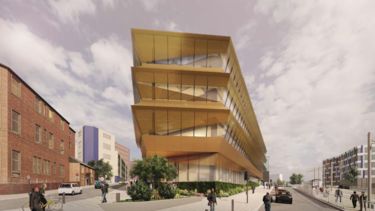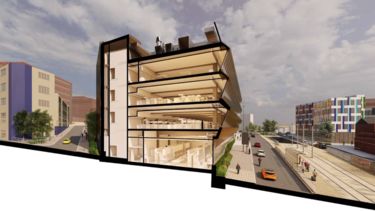Central Teaching Laboratory
The Central Teaching Laboratory (CTL) project is the creation of a five storey world class flexible and multi-functional teaching laboratory with state of the art facilities.

Overview
The CTL will be used for teaching predominantly by the Faculty of Science but also other lab based teaching including for the Faculty of Health. It will include two teaching laboratories both with a capacity of 300, a fume cupboard lab, an anatomy lab, associated technical support rooms and a digitally enabled teaching space. The building will also provide student-led learning space. A full list of the spaces to be included in the building is provided in the Brief Finalisation section of the design and access statement.
The location for CTL is on Upper Hanover Street. The boundary includes Leavygreave Road on it's north side and Hounsfield Road on the south. Further information about the existing site is provided in the Location section below.
Project Vision
- The development of a world class flexible and multi-faceted teaching laboratory
- Provision of state of the art facilities to enable a multi-functional laboratory and servicing areas, to support teaching of all disciplines at the same time, to improve the management and delivery of teaching.
- By removing the embedded teaching laboratories across the estate, release space across the Faculty of Science for alternative use by the whole University.
Key Project Drivers
| Improve student and staff experience | Attract high quality students to Sheffield |
| Meet University sustainability targets | Improve utilisation and efficiency of space |
| Underpin the academic vision and research collaboration | Provide world class teaching facilities |
The vision and key project drivers can be distilled into four 'themes" as shown in the CTL Holistic Design diagram.
Design
Note - all images shown are architectural visualisations of the building.
Irregular shape
The site is an irregular shape due to the location of the Computer Centre (bottom right on the image). The Centre is a key piece of infrastructure and cannot be moved. The irregular site shape has dictated the location of the key requirement of two large 300 capacity rectangular superlabs.
The front of the building is the only zone they can be accommodated in. By being positioned along Upper Hanover Street the labs optimise the full length of the site allowing for both views in from street level and views out onto the street.
Those views in and out underpin one of the core principles for the project in the creation of a “window to science”.
Geometric design to help with sunlight
Careful design consideration of the building is also required to minimise solar gain and glare - the impact of the sun and it’s heat - whilst enabling visibility to and from the laboratory spaces - providing good amounts of natural light but not so it’s too bright to be able to work in. Extensive work has been undertaken to determine the impact of the solar gain and has proven to be a key driver for the design.
The geometric design provides a key function as well as creating a striking building. The up facing angled solid aluminium panels shield the building from the sun. The glazed panels face down to reduce solar exposure. The anodised aluminium mesh panels have also been added to the outer face of the glazing further reducing solar gains as well as mitigating issues with glare, sun patches and direct sunlight on work surfaces.
Green wall at ground level
The ground floor (Level B) which benefits from some overhang from the floors above will have vertical windows, with a green wall on the north, east and south facades. Parts of the Hounsfield Road and Leavygreave Road sides which are much more solid compared to the Upper Hanover Street glazing will have a vertical rainscreen using the same anodised aluminium mesh finish.
Alongside performing the key functions described above, the iridescent nature of the anodised aluminium will change throughout each day as the light and shadow fluctuates, giving depth and interest to the building.
Location
The eastern edge of the site is bounded by Upper Hanover Street, adjacent to the University Tram Stop. The main entrance for the building will be from Leavygreave Road - which will be opposite to the Information Commons entrance and is a part of the “Gold Route” (as shown in the image above). Hounsfield Road will provide suitable access to service the building with a discreet and secure zone within the building footprint.
The project also includes the creation of a pocket park located to the north west of the new building site, with boundaries of Leavygreave Road and Favell Road. The site for the pocket park will be used as a work area by the building contractors whilst the construction takes place, after which it will be landscaped.
Both sites are shown on this Site Location aerial view marked with a red boundary line. The green highlighted buildings are those owned by the University. A more zoomed in plan with nearby main road names included is available in the Site Location Plan from the design and access statement.
A simple timeline of history of the site from 1965 can also be viewed. There are four buildings that sit alongside Hounsfield Road that would need to be demolished along with the removal of nine mature trees and a low level wall along Upper Hanover Street. These are shown on the Existing Site Uses Plan.
Sustainability
The aspiration for CTL is to be a wholly sustainable building, through its design, construction, function and use.
Sustainable Design
The initial design idea was to include a basement. However from site investigation indicating a high water table, a basement has been omitted as it would have significantly increased the project's carbon footprint and make it less environmentally sustainable.
The anodised aluminium being proposed as the main facade material has a long lifespan of 75 years and is highly recyclable (>90% can be recovered through recycling).
Our goals are to achieve net zero carbon in operation and a maximum embodied carbon level of 700Kg CO2/m2. This is a key principle as we develop the strategy for CTL. The preliminary sustainability initiatives are listed in the Sustainability Agenda and Approach included in the project's design and access statement.
The heating, cooling and hot water for the building will be through the use of air source heat pumps. The heat pumps are fully electric and will mostly operate on the University's 100% renewable electricity contracts.
Trees and Biodiversity
During the design process extensive consideration has been given to the existing trees on the site - 8 Planes and 1 Birch. The root ball of a mature tree has a similar dimension to that of its canopy and there is a defined Root Protection Area around each tree.
A primary requirement of the building is to provide two 300 capacity laboratories. Therefore it is not possible to reduce the footprint of the building and retain the trees.
Consideration of moving the trees
We have sought expert opinion to moving the trees but due to their close proximity to critical services with the public footpath unfortunately there would be too much risk to the protection of these services. The Utility Survey from the Design and Access Statement provides a visual of the utility services in and around the project site.
Note August 2024 - we are currently obtaining a second opinion on the possibility of moving the trees - to double check where this is a possible option.
Tree Replacement Policy
The felling of trees is always the last resort for the University and in accordance with our policy we will be planting replacement trees as close to the site as possible at a ratio of 2:1 with semi mature trees in the next growing season. Suggested locations including the pocket park, in front of Information Commons and near to Western Bank are included in this Tree Replacement Map. The tree replacement strategy also incorporates planting trees at Endcliffe Village, where the University has a large amount of student residences - including in this second tree replacement map. The maps are proposing locations for 26 replacement trees in total which includes the eight replacements for the four trees near to Hounsfield Road that have already been removed. This is the relocation of a substation which is being built as the existing one is located on the CTL site.
Biodiversity
Our University has a policy to improve biodiversity value of the existing estate and where possible contribute to local, regional and national biodiversity targets. More information about the policy is available in our Biodiversity Action Plan.
The biodiversity assessment of the existing site rated it as 'very low distinctiveness habitats, developed land, sealed surface building and urban individual trees which are assigned medium distinctiveness'.
The landscaping for the pocket park will incorporate enhancing opportunities for pollinators through the creation and enhancement of grassland, provide cover for urban wildlife through native shrub planting, and provide a greater diversity of native plants and grasses of varying heights and structure.
Economic benefit
The economic impact of CTL for the benefit of Sheffield has been investigated and a report created. Sheffield’s economy will benefit directly because of the construction related activity taking place on the proposed site throughout the CTL’s build phase. However, further benefits will accrue locally due to the subsequent supply chain and the consumer spending impacts. It estimates that the total
(direct, indirect and induced) impact could generate 720 job years of employment in the local economy, with associated wages of £21 million and GVA contributions of £37 million.
The benefits will be larger still at the national level and is estimated to include £20 million in tax revenues to the Treasury over the CTL’s seven-year development phase (starting 2022).
This is in addition to the economic impact of updated teaching facilities attracting high quality prospective students and improving the overall student experience, alongside the increased space utilisation and consolidation of the currently ageing Science estate.
For more information please consider the full economic impact report.
Contact
If you have any queries about the Central Teaching Laboratory please email ctl@sheffield.ac.uk.







